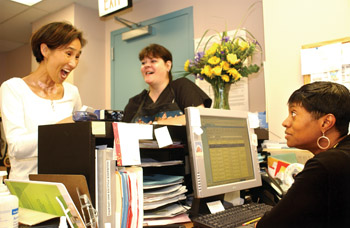
Patient Youb Kim, Ph.D., left, talks with Beverly Webb and Melanie Richardson at the Vanderbilt Phototherapy Clinic.
Photo by Mary Donaldson
Patients benefit from Phototherapy Clinic’s dedication
The Vanderbilt Phototherapy Clinic takes patient care to heart, making a profound difference in many lives and illustrating why Vanderbilt University Medical Center is deserving of Magnet Recognition.
Supervised by Jami Miller, M.D., the three-person clinic is a treatment arm of the Department of Dermatology, providing various hydro and ultraviolet light therapies. Patients with severe psoriasis, types of lymphoma and other chronic skin conditions come to the phototherapy clinic and enter a warm, accepting world of patient-focused care.
“When I read how high the suicide rate is for people with severe psoriasis, I became very grateful that we have a place like this,” said Barbara Brown, R.N. “I can't provide them insurance, but I can hold their hands during the toughest times.”
Every decision about the clinic revolves around providing and constantly enhancing patient care. Unfortunately, many patients with severe skin problems feel ostracized and embarrassed about their visible conditions, and are often misunderstood by the public at large. The phototherapy clinic is conveniently located on the sixth floor of the Medical Arts Building, so patients can easily visit the clinic with minimal interaction with other hospital visitors.
Many patients are prescribed three- to five-day-a-week phototherapy treatment regimens that can last six weeks or more.
Brown, Beverly Webb, cosmetologist, aesthetician, and Melanie Richardson, office assistant, are determined to make a patient's visit an upbeat and positive experience. Instead of referring to their work as a traditional clinic, they suggest patients think of their visit as “spa treatments” and deliver celebrity treatment to each patient.
Brown and Webb helped open the phototherapy clinic in 1993 and have been there ever since. Richardson joined the team almost four years ago. Mary Lou Gudelis, assistant manager in specialties practice, is nurse manager providing support as well as room for the employees to grow.
The clinic is equipped with three standup ultraviolet light units that look similar to upright tanning beds. There is phototherapy equipment for the hands and feet as well as regionally distinctive hydrotherapy equipment.
“We treat the person, not just the skin,” said Webb. “We get to know people throughout their lives and we still see some of our original patients.”
They recall one particular teenager they treated years ago with a severe flareup of psoriasis. She tried to attend school, but couldn't stand the constant teasing from classmates. She received daily treatments, went into remission, and returns periodically through the years when necessary. The shy teenager is now a mother and head of a local psoriasis support group.
“I feel I'm serving a higher calling by working here,” said Richardson, who serves as the voice of the clinic and plays a key role as the first person most patients meet.
In addition to the high-level of care and the emotional investments in their patients, the phototherapy team often scrambles to find foundations that will help cover their uninsured patients.
Phototherapy patients are engaged in their care and connect with their caregivers. It's not unusual for patients to share recipes, books or home-grown vegetables.
“These women are like my sisters,” said patient Youb Kim, Ph.D. “This place is a 'lighthouse,' a place to heal, to validate and leave more positive than when you came in.”
When asked about the Magnet Recognition site visit, Webb sums it up like this: “Magnet is about the people. We care about each other as co-workers and always work toward improvement.”
“I couldn't have been a missionary in a foreign land and done work that was more fulfilling,” said Brown. “We can't give enough, because we get back more.”













